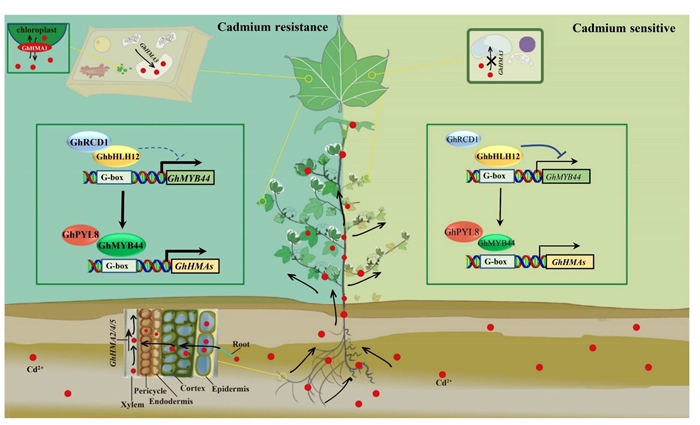Identification of molecular regulatory mechanisms for cotton tolerance to heavy metal cadmium
Recently, a paper entitled “GhRCD1 promotes cotton tolerance to cadmium by regulating the GhbHLH12-GhMYB44-GhHMA1 transcriptional cascade” has been published by the Plant Biotechnology Journal. In the paper,researchers from the Institute of Cotton Research (CCRI) report that the oxidative stress regulatory protein GhRCD1 response to cadmium stress by regulating the molecular mechanism of GhbHLH12-GhMYB44-GhHMA1 transcriptional pathway, providing new ideas for cultivating new cadmium tolerant cotton varieties and reducing cadmium pollution through plant remediation methods.
Due to mining, electroplating, cadmium containing wastewater discharge, and misuse of rock phosphate fertilizers, pesticides and other production activities at present, the problem of soil heavy metal pollution in China is becoming increasingly prominent.As a non-food crop primarily grown for industrial purposes, cotton has a natural advantage inphytore mediation of Cd2+ pollution in soil compared to the food crops (wheat, rice, and corn), the oil crops (peanut and soybean),and the vegetables (beans, cucumbers, and tomatoes), circumventing the risk of Cd2+ entering the food chain.Therefore, it is crucial to explore the precise regulatory mechanisms of cotton in response to cadmium stress.
This study identified a cadmium sensitive cotton T-DNA insertion mutant ghrcd1 and confirmed the involvement of GhRCD1 in the oxidative stress response caused by heavy metal cadmium by creating a GhRCD1 gene knockout mutant. GhRCD1 directly interacts with the cadmium tolerant negative regulatory factor GhbHLH12, thereby alleviating the transcriptional inhibition effect of GhbHLH12 on its downstream regulatory gene GhMYB44 . Subsequently, the high expression of GhMYB44 activated the expression of cadmium transport related genes GhHMAs . Upregulated GhHMA3 increased the accumulation of cadmium in vacuoles, while upregulated GhHMA1 alleviated the harm of cadmium stress on leaf photosynthesis. Ultimately, cotton materials with high expression of GhMYB44 enhanced their tolerance to cadmium stress. The results showed that the oxidative stress regulatory protein GhRCD1 improved cotton's tolerance to cadmium stress by regulating the GhbHLH12-GhMYB44-GhHMA1 module. This study provides excellent genes and materials for cultivating cadmium resistant cotton varieties, expanding the application of cotton in controlling soil heavy metal pollution.
This study has been supported by projects such as the National Natural Science Foundation of China (31621005, 32201762), the Innovation Program of Chinese Academy of Agricultural Sciences,the Outstanding Youth Foundation of He’nan Scientific Committee (222300420097), the Hainan Yazhou Bay Seed Laboratory(Grant Nos. B23CJ0208), China Agriculture Research System of MOF and MARA CARS-15-02), and the China Postdoctoral Science Foundation (2022M723460). The co-first authors of this paper are Wei Xi, a PhD candidate from the China Cotton Institute and Henan Normal University, Geng Menghan, a Master's degree candidate from Henan Normal University, Yuan Jiachen, a PhD candidate from Zhengzhou University and the China Cotton Institute, Dr. Zhan Jingjing, and Dr. Liu Lishen. Researcher Ge Xiaoyang and researcher Li Fuguang from the China Cotton Institute, Associate Professor Zhao Hang from Qufu Normal University, and Professor Duan Hongying from Henan Normal University are the co-corresponding authors.
The article can be found:https://doi.org/10.1111/pbi.14301

Fig 1. Schematic diagram of the pathway of GhRCD1-GhbHLH12-GhMYB44-GhHMA1 regulating cotton Cd2+tolerance
By XiaoyangGe (gexiaoyang@caas.cn)
-
 Apr 18, 2024Opening Ceremony of the Training Workshop on Wheat Head Scab Resistance Breeding and Pest Control in Africa Held in CAAS
Apr 18, 2024Opening Ceremony of the Training Workshop on Wheat Head Scab Resistance Breeding and Pest Control in Africa Held in CAAS -
 Apr 03, 2024IPPCAAS Co-organized the Training Workshop on Management and Application of Biopesticides in Nepal
Apr 03, 2024IPPCAAS Co-organized the Training Workshop on Management and Application of Biopesticides in Nepal -
 Mar 28, 2024Delegation from the School of Agriculture and Food Science of University College Dublin, Ireland Visit to IAS, CAAS
Mar 28, 2024Delegation from the School of Agriculture and Food Science of University College Dublin, Ireland Visit to IAS, CAAS -
 Mar 25, 2024Director of World Food Prize Foundation visited GSCAAS
Mar 25, 2024Director of World Food Prize Foundation visited GSCAAS -
 Mar 20, 2024Institute of Crop Sciences (ICS) and Syngenta Group Global Seeds Advance Collaborative Research in the Seed Industry
Mar 20, 2024Institute of Crop Sciences (ICS) and Syngenta Group Global Seeds Advance Collaborative Research in the Seed Industry
